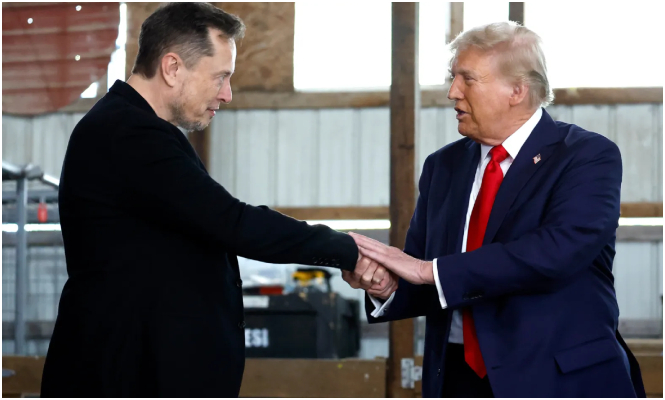The U.S. Department of Government Efficiency — better known as DOGE, the high-profile Trump–Musk venture created to slash the size of the federal workforce — has ceased to exist, according to new reporting from Reuters, marking an unceremonious end to one of the most talked-about experiments in modern American governance.
The confirmation came quietly.
“That doesn’t exist,” Office of Personnel Management (OPM) Director Scott Kupor told Reuters when asked about DOGE’s status. With that statement, an agency launched with fanfare and Silicon Valley swagger effectively vanished eight months before the end of its government-mandated charter.

A Bold Promise That Fell Dramatically Short
When DOGE was created in January of Trump’s second term, it carried a sweeping mission: reduce the federal government, rewrite regulatory systems using AI, and deliver historic cuts to Washington’s workforce and budgets. Elon Musk, who initially led the unit, promised more than $1 trillion in savings.
According to Reuters, DOGE ultimately delivered only about $8 billion — a fraction of the projection and far below the expectations its founders set.
The agency’s early days were aggressive and theatrical. Musk appeared at the Conservative Political Action Conference waving a chainsaw above his head, calling it “the chainsaw for bureaucracy.” Senior DOGE staffers were dispatched to agencies across Washington with instructions to eliminate positions, consolidate programs, or redirect priorities toward the administration’s political agenda.
Yet many of those moves were reversed or blocked by the courts. Federal judges repeatedly ruled that DOGE-driven personnel restructurings violated civil-service protections. By late 2024, watchdog groups and independent economists were openly questioning DOGE’s inflated savings claims, which were never backed by detailed public accounting.
OPM Quietly Absorbs DOGE’s Work
Reuters reports that the OPM has now assumed many of DOGE’s responsibilities. The shift was not announced publicly, but internal documents reviewed by the news agency show the agenda sliding out of DOGE’s hands.
A government-wide hiring freeze — one of DOGE’s signature tools — is also over.
“There is no target around reductions anymore,” Kupor confirmed.
The change marks a practical acknowledgement that the “one-in, four-out” hiring policy and sweeping personnel cuts were unsustainable across agencies responsible for national security, healthcare, scientific research, and public safety.
DOGE Staff Redeployed — Including to Website “Beautification”
Perhaps the most unusual twist in DOGE’s demise involves the reassignment of its staff.
Two prominent DOGE members have joined the National Design Studio, a new executive-created group charged with “beautifying” federal websites. It is led by Airbnb co-founder Joe Gebbia, who once served on Musk’s DOGE team. Another DOGE figure, Edward Coristine — known online by the nickname “Big Balls” — encouraged the public to apply for roles at the new design body.
Other former DOGE actors have found new homes inside the administration:
- Zachary Terrell, once involved in health-system access reviews, is now Chief Technology Officer at the Department of Health and Human Services.
- Rachel Riley, who held similar system-level access, is now a senior official at the Office of Naval Research.
- Jeremy Lewin, who helped dismantle the U.S. Agency for International Development, has moved to the State Department to oversee foreign assistance programs.
And while DOGE is gone, the administration continues work on AI-driven regulatory review. Scott Langmack, a former DOGE representative, has been assigned to develop tools to analyze and eliminate federal regulations.
Mixed Signals and a Quiet End
The administration never publicly announced DOGE’s dissolution. Officials continued to refer to the agency in the past tense, even though Trump himself had signed an order extending it through July 2026. Musk and Trump feuded publicly in May, and Musk temporarily distanced himself from Washington — though he returned this week for a White House dinner with Saudi Crown Prince Mohammed bin Salman.
The fading of DOGE stands in stark contrast to its bombastic rollout. What was billed as a revolutionary tool to “delete the mountain” of government bureaucracy instead slipped quietly into obscurity, overtaken by internal challenges, legal roadblocks, and the reality that modern governance is more complex than any chainsaw demonstration.
A Stark Symbol of Ambition vs. Reality
DOGE’s closure is, in many ways, an implicit acknowledgment that the experiment didn’t deliver on its central promise. Cutting government — at scale, quickly, and without destabilizing essential services — proved far harder than anticipated.
The administration still insists the broader mission continues.
“President Trump was given a clear mandate to reduce waste, fraud and abuse… and he continues to actively deliver on that commitment,” a White House spokesperson told Reuters.
But DOGE, the symbol of that mission, is gone.
For a project born with Silicon Valley bravado, the ending is surprisingly quiet — and a reminder that governing, unlike coding, rarely responds to big personalities and big promises alone.
Attribution: This report relies on original reporting by Reuters, including its November 23 article, “DOGE ‘doesn’t exist’ with eight months left on its charter.”
